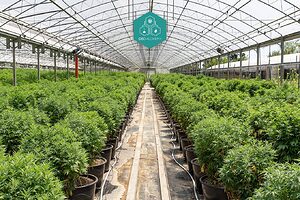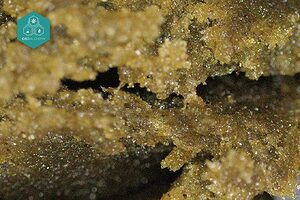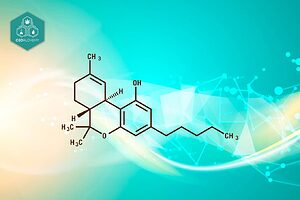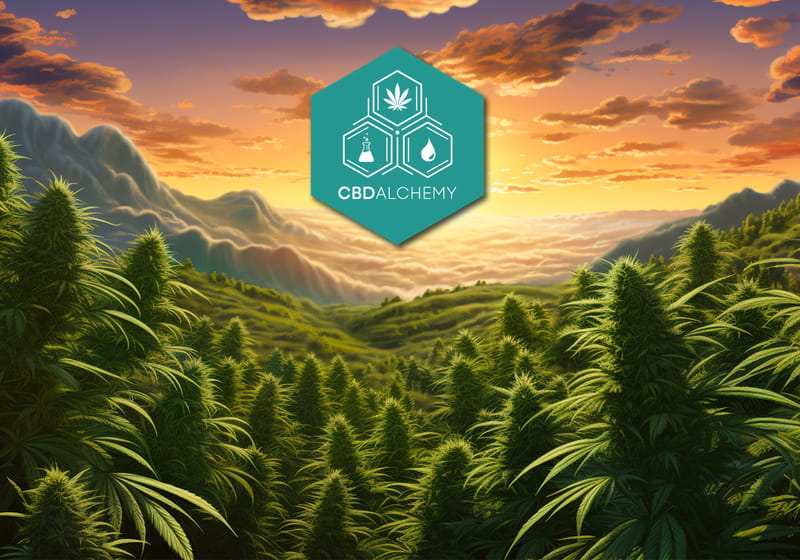- Key Points
- Function of marijuana leaves
- Types of marijuana leaves
- Fan leaves and sugar leaves
- Health indicators in marijuana leaves
- Common Pests and Diseases of Marijuana Leaves
- Uses of marijuana leaves
- CBD 20% Oil – Full Spectrum – Cannabis Leaf and Hemp Seed Oil
- Marijuana leaf photos
- Summary
- Frequently asked questions

The marijuana leaf is vital to the cannabis plant. In addition to its role in photosynthesis, it has medicinal and recreational uses. Here you will learn about its benefits, applications and types.
Marijuana leaves as well as CBD flowers contain cannabinoids, which are important compounds for their medicinal and recreational uses.
Key Points
- Marijuana leaves play crucial roles in photosynthesis, nutrient storage and regulation of the plant’s water balance.
- There are three main types of marijuana leaves (Sativa, Indica and Ruderalis), each with unique physical characteristics adapted to different climatic conditions and growing needs. In addition, the genetics of each type of marijuana leaf influences its physical characteristics and growing needs.
- Marijuana leaves can be used in a variety of applications, such as in the production of tea, marijuana butter, essential oils and compost, taking advantage of their therapeutic and nutritional properties.
Function of marijuana leaves
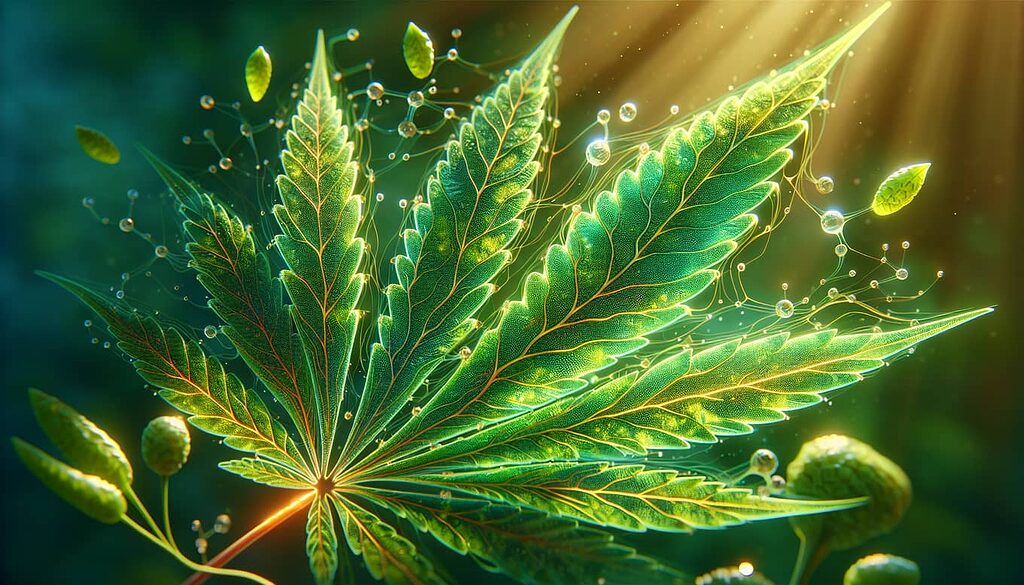
Marijuana leaves, full of chlorophyll, are essential for photosynthesis, the process by which the plant converts sunlight into energy for growth and development. These green organs capture carbon dioxide, sunlight and water to generate glucose and other by-products that nourish the plant.
In addition to photosynthesis, marijuana leaves store nutrients and water, helping to regulate water balance. They also play a crucial role in plant respiration and transpiration, regulating gas exchange and water evaporation.
Types of marijuana leaves
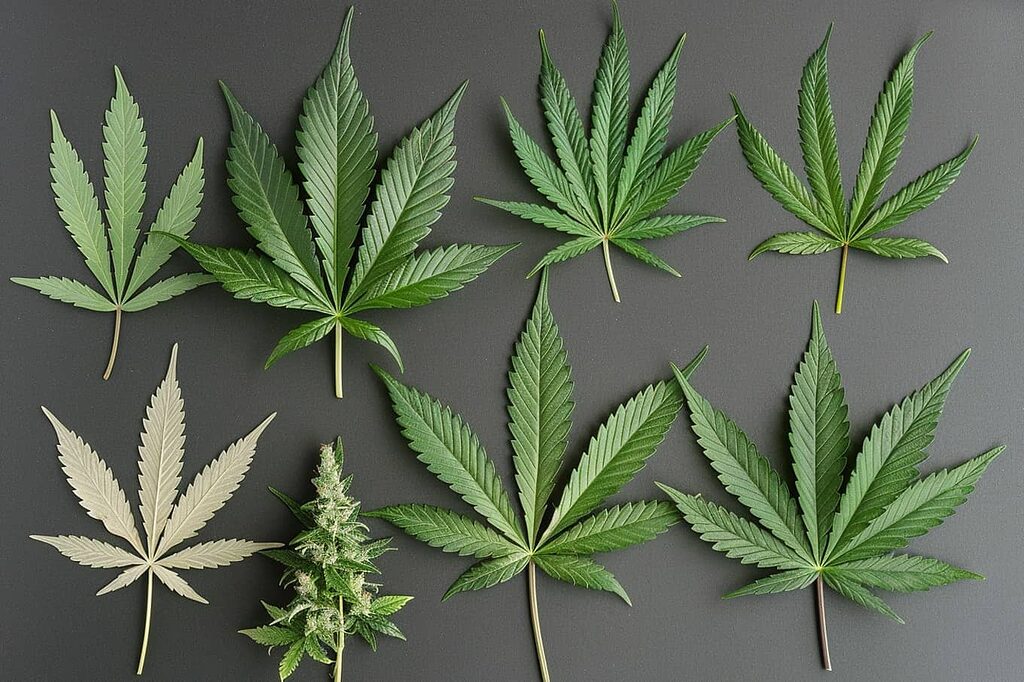
There are different types of marijuana leaves depending on the variety of the plant: sativa, indica and ruderalis. Each type has unique shapes and characteristics that suit different climatic conditions and growing purposes.
Below, we will explore each of these forms in detail.
Sativa marijuana leaves
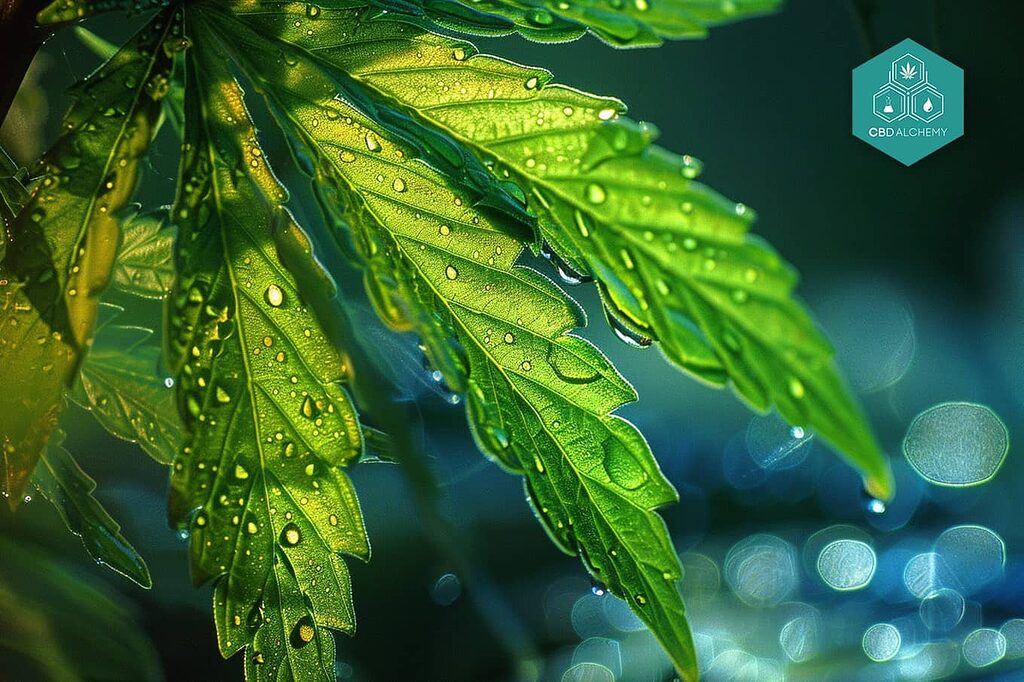
Marijuana sativa leaves, also known as marijuana leaf, are:
- Elongated and thin
- With pointed edges that give them an elegant and distinctive appearance
- Their light green color reflects a lower chlorophyll density, which allows them to maximize efficiency in warm, sunny climates.
These cannabis leaves contain more leaflets than indicas, giving them a more open and airy structure. In general, cannabis sativa plants can reach impressive heights, adapting perfectly to regions with long periods of sunlight.
Indica marijuana leaves
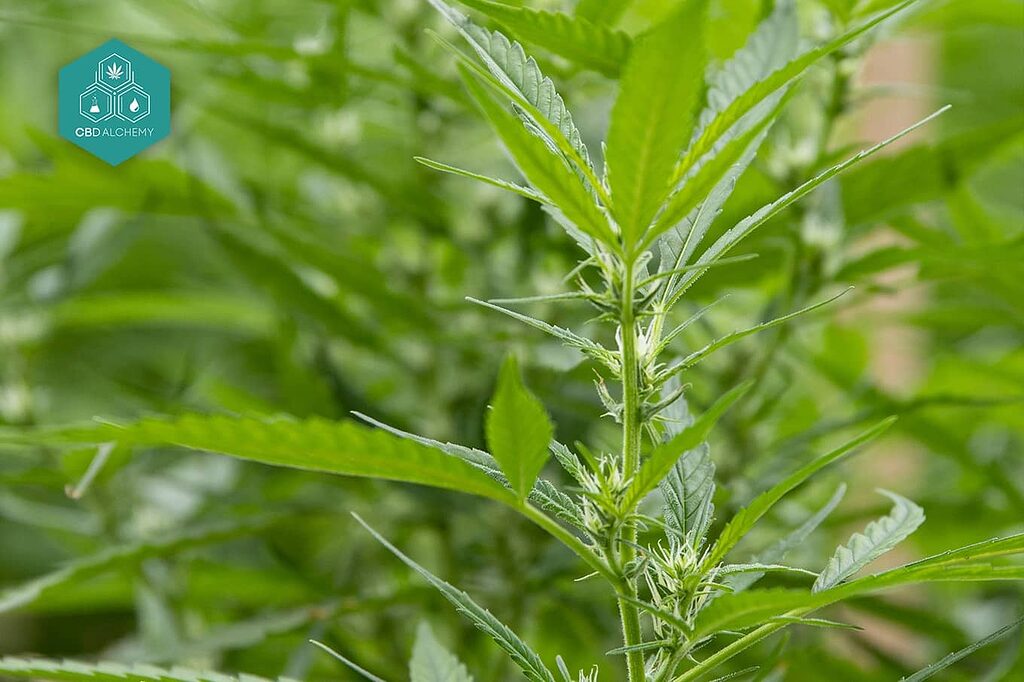
Indica marijuana leaves are distinguished by being smaller, wider and of a deep dark green color. These physical characteristics allow indica plants to absorb light in colder, less sunny climates. Like hemp, indica leaves are adapted to thrive in adverse environmental conditions.
Generally, indica leaves have the following characteristics:
- They have between 7 and 9 leaflets, which gives them a denser and more compact structure.
- Their shape is wide.
- They have a dark color. These characteristics are indicative of their ability to thrive in adverse environmental conditions.
Ruderalis marijuana leaves
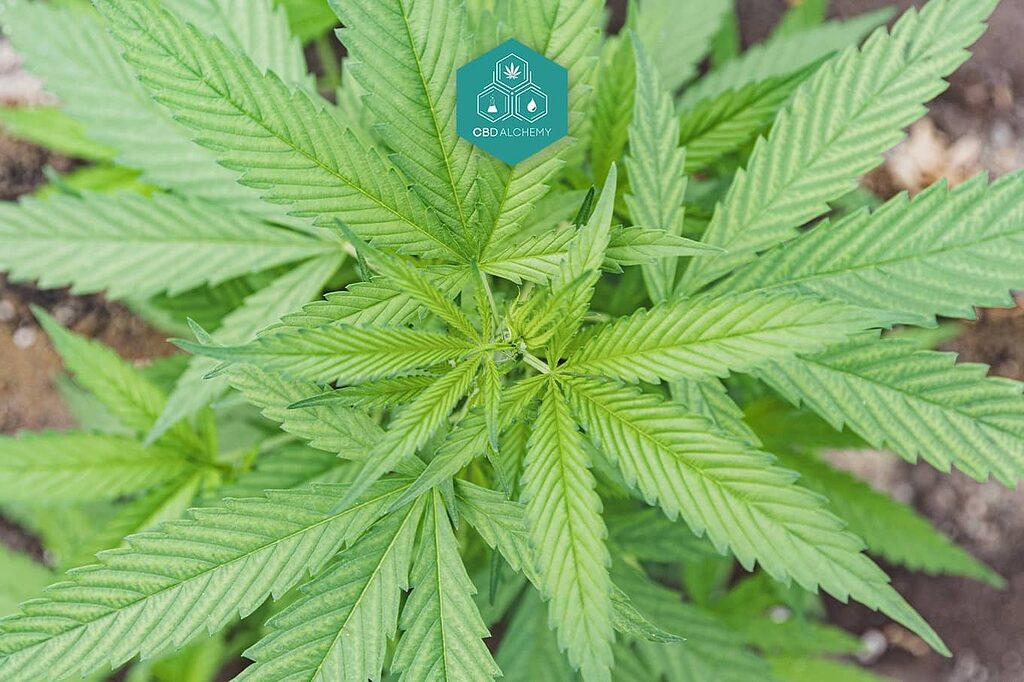
Marijuana ruderalis leaves are thin and usually have between 3 and 5 leaflets. These leaves resemble those of a young sativa plant both in shape and color, but with the remarkable ability to flower independently of the hours of light.
This autonomy allows them to adapt to a variety of environments, especially those with less predictable light conditions, making ruderalis plants valuable for breeding autoflowering hybrids with a diverse genetic base.
Fan leaves and sugar leaves
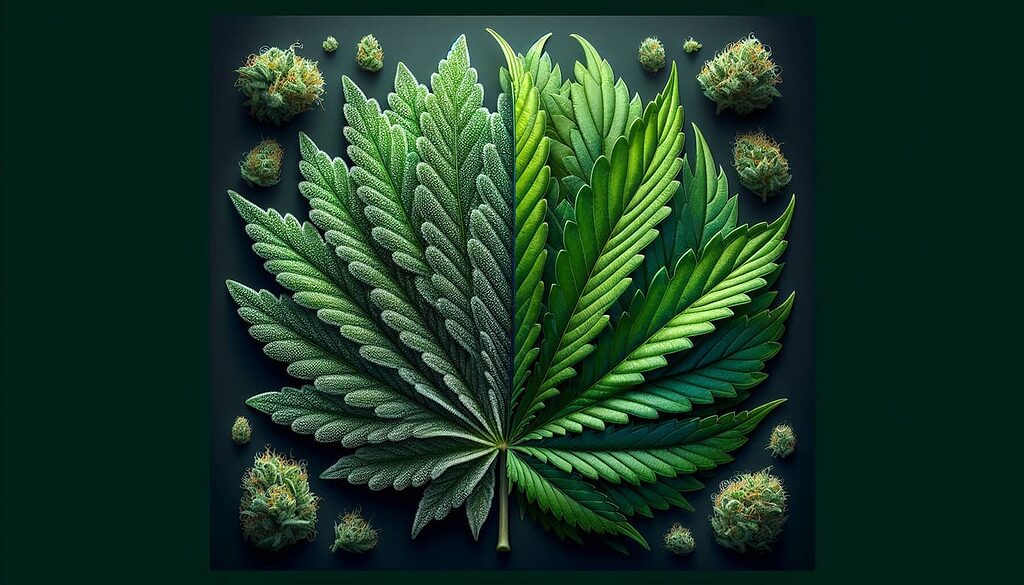
Fan leaves are the largest leaves of the marijuana plant and play a crucial role in photosynthesis by capturing as much sunlight as possible. These leaves also help maintain the water balance of the plant.
In contrast, sugar leaves are smaller and sprout directly from the buds, being covered with white trichomes that give them a glazed appearance. These trichomes contain valuable compounds such as cannabinoids, CBD and terpenes, although in smaller quantities than in the flowers, and are ideal for making hashish or marijuana butter.
Health indicators in marijuana leaves

Marijuana leaves can be a valuable indicator of plant health, showing signs of problems such as yellowing, curling or dryness. These symptoms can indicate nutritional deficiencies, pests or diseases, and it is crucial to address them quickly to keep the plant healthy. Excess carbon dioxide in the growing environment can also affect leaf health.
Yellowing leaves

Yellowing leaves can be a sign of nutritional deficiencies, such as a lack of nitrogen, which manifests itself on the leaf tips in the lower zone of the plant. In addition, problems such as overwatering, root rot and fluctuations in pH can cause leaves to turn yellow. Plant genetics can also influence susceptibility to leaf yellowing.
Whitefly infestations can also lead to leaf discoloration as these insects suck sap from the plant, weakening it and causing visible damage.
Leaf curl
Leaf curling can be caused by multiple factors, including:
- Heat stress
- Excessive irrigation
- Over-fertilization
- Low temperatures
A sudden increase in temperature can cause leaves to curl as a defense reaction of the plant.
Leaf curling can be caused by several factors, such as:
- Lack of direct sunlight
- Lack of water
- Excessive irrigation
- Over-fertilization
- Low temperatures
These factors can alter nutrient balance and water management in the plant, negatively affecting leaf health and development.
Dry and brittle leaves
Heat stress can dry and crisp marijuana leaves, especially if they are in close proximity to light bulbs. This problem is especially evident in indoor growing environments where proximity to the light source can cause excess heat. Excessive carbon dioxide in the growing environment can also contribute to dry and brittle leaves.
Dry, brittle leaves are a common indicator of problems in marijuana plants, negatively affecting the overall health of the plant. It is crucial to adjust environmental conditions to avoid this type of stress and keep leaves healthy.
Common Pests and Diseases of Marijuana Leaves
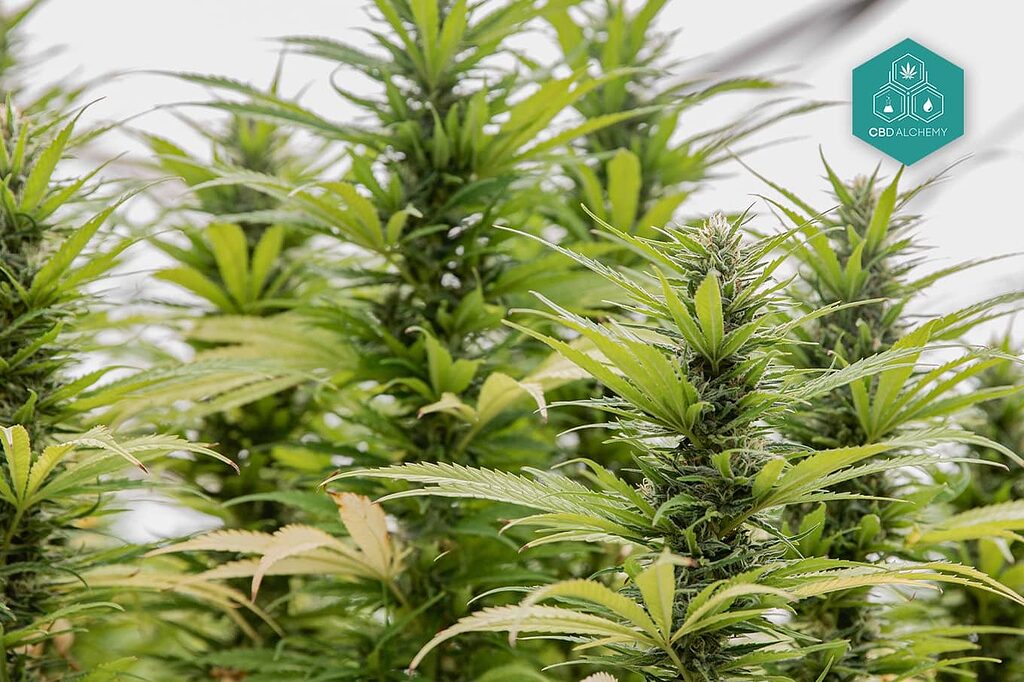
Pests and diseases are a constant threat to marijuana leaves. Among the most common are spider mite, whitefly and powdery mildew. These problems can cause significant damage if not properly controlled. As in hemp, pests and diseases can cause significant damage to marijuana leaves if not properly controlled.
Spider mite
Spider mite is a tiny mite that varies in color from greenish brown to deep red depending on maturity. Each female can lay 3 to 5 eggs per day, rapidly infesting the plant. Damage manifests as whitish or grayish spots on the leaves due to sap absorption. Plant genetics can influence its resistance to spider mite infestation.
In advanced stages, spider mites form webs on leaves, stems and flowers, severely affecting plant health. To control them, it is effective to increase air circulation and decrease humidity in the growing environment.
Whitefly
Whitefly can be detected by sight:
- Small white insects jumping when moving the plant
- These insects produce a sticky honeydew on leaves, which can attract mildew
- Whiteflies lay their eggs on the underside of leaves, causing discoloration and weakening.
Excessive carbon dioxide in the growing environment can attract whiteflies.
Soapy water and neem oil treatments can be used to combat whitefly infestation. Potassium soap is also effective in treating these infestations on marijuana plants.
Powdery mildew
Powdery mildew manifests itself as a white, powdery coating on marijuana leaves. High humidity conditions favor its development, making it a common problem in poorly ventilated crops. As in hemp, powdery mildew can cause significant damage to marijuana leaves if not properly treated.
To treat powdery mildew, specific fungicides or homemade solutions such as a 33% milk and water mixture can be used.
Uses of marijuana leaves

Marijuana leaves contain cannabinoids that can be used in a wide range of applications, from making infusions and edibles to essential oils and salves.
Below, we’ll explore in detail some of the most common and beneficial uses of these versatile leaves.
Marijuana leaf tea
Marijuana leaves can be used to make infusions, taking advantage of their properties without the psychoactive effects. Marijuana tea is a healthy way to consume the plant, avoiding the inhalation of toxins and toxic smoke. It is important to mention that the marijuana leaves used for the tea must be properly dried in the sun to preserve its properties.
This tea can help reduce pain related to rheumatic diseases and migraines thanks to its analgesic and anti-inflammatory properties. To prepare it, it is recommended to boil the dried leaves in water for 15-20 minutes.
To improve the extraction of hydrophobic cannabinoids, we recommend adding a small amount of milk or alcohol to your infusion. These natural components help combine and dissolve the cannabinoids, which can improve the body’s ability to absorb CBD when ingested in the beverage.
Integrating CBD infusion into your daily wellness routine is a simple step. For example, drinking this relaxing beverage about an hour before bedtime will help promote a state of relaxation conducive to a good night’s sleep. L
CBD infusion has relaxing properties that can successfully reduce anxiety and promote deep relaxation, preparing both the body and mind for a peaceful and restful sleep.
Marijuana butter
Sugar leaves are ideal for making hash or marijuana butter because they are rich in trichomes. To make marijuana butter, first decarboxylate the leaves by baking them at 110-140 degrees Celsius for 30-45 minutes. Like hemp, marijuana leaves can be used to make cannabinoid-rich butter.
The shredded marijuana is then boiled in water over low heat for 20 minutes to remove impurities, and then mixed with melted butter, simmering for 30 minutes. The resulting butter can be strained and stored in the refrigerator for up to two weeks.
CBD 20% Oil – Full Spectrum – Cannabis Leaf and Hemp Seed Oil

CBD Alchemy’s Full Spectrum CBD oil with hemp oil is a high quality product, made from organic hemp with a THC level of less than 0.2%, complying with European Community standards. This oil is ideal for people already familiar with CBD who are looking for a versatile and effective product.
The 20% concentration ensures a potent cannabinoid content, offering all the benefits of CBD along with other natural compounds of the plant. This allows you to take advantage of the entourage effect, where the different components act synergistically to enhance the therapeutic effects.
Marijuana leaf composting
Composting marijuana leaves is an excellent way to enrich the soil of the crop with additional nutrients. Discarded leaves can be composted to add valuable nutrients to the soil, improving its fertility and structure. Composting marijuana leaves also helps reduce carbon dioxide in the growing environment.
In addition to reducing waste, composting marijuana leaves promotes sustainable growing practices. This technique allows plant debris to be recycled, closing the nutrient cycle and benefiting both the environment and future crops.
Marijuana leaf photos
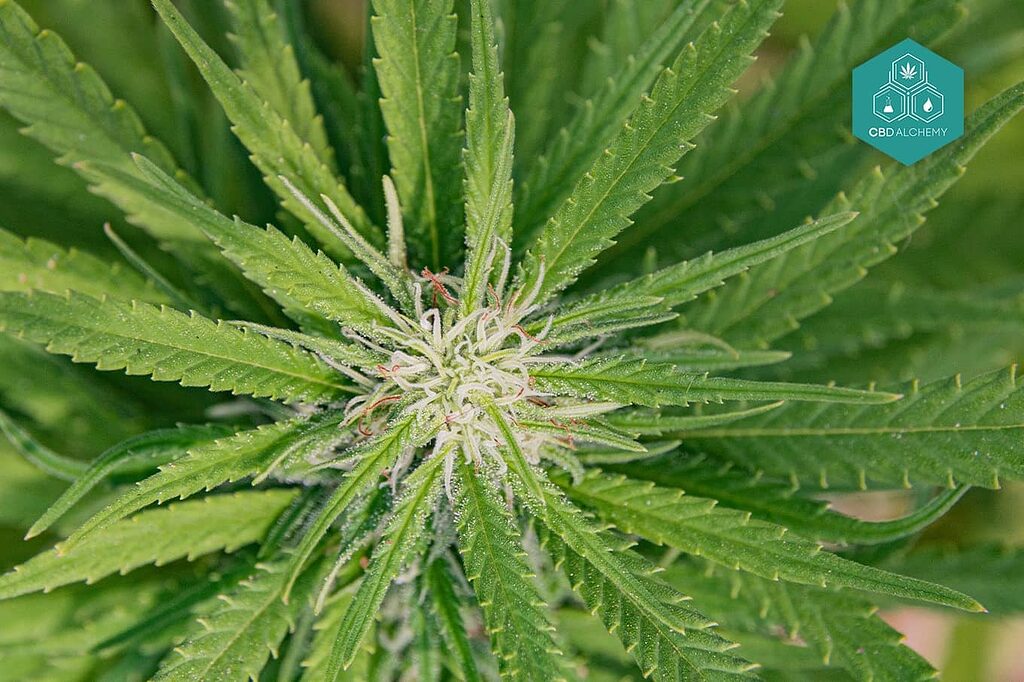
Cannabis image galleries offer shapes and details of the plant:
- High quality, high resolution artistic compositions that capture the beauty and detail of the plant
- Images suitable for a variety of uses, such as marketing and education
- Helps convey messages and normalize cannabis in society
In the world of cannabis photography, it is important to understand the difference between marijuana and CBD images. With over 125,900 images available on reputable sites like iStock, finding the perfect image can seem overwhelming, but it can also be a rewarding experience for those with an artistic streak and an interest in cannabis.
Summary
In short, marijuana leaves contain cannabinoids essential to the plant’s health and have a wide range of uses, from photosynthesis to making products like tea and marijuana butter.
By understanding the different strains and their characteristics, as well as the signs of leaf health, growers can optimize the care of their plants and make the most of their benefits. Explore and experiment with marijuana leaves to discover their full potential!
Frequently asked questions
How many days does the effect of Cannabi last?
The effect of cannabis can last between one and three hours when smoked, while consuming cannabis-infused food or beverages can last for many hours. Traces of THC can remain in the body for days or even weeks.
What does the marijuana leaf look like?
The leaf of the marijuana plant is palmaticompuesta, with odd-numbered leaflets, lanceolate and with serrated margins, presenting bilateral symmetry. There is no doubt that the marijuana leaf is palmaticompuesta and has leaflets with specific characteristics.
What is the function of marijuana leaves?
Marijuana leaves have the function of carrying out photosynthesis, storing nutrients and water, as well as participating in the plant’s respiration and transpiration. Their role is crucial for the development and survival of the plant.
What are the main types of marijuana leaves?
The main types of marijuana leaves are sativa, indica and ruderalis, each with unique characteristics and growing conditions. It is important to know them to better understand the plant.
What does leaf yellowing indicate?
Yellowing leaves can be a sign of nutritional deficiencies, overwatering, root rot or whitefly infestations. It is important to identify the cause in order to take corrective action.


